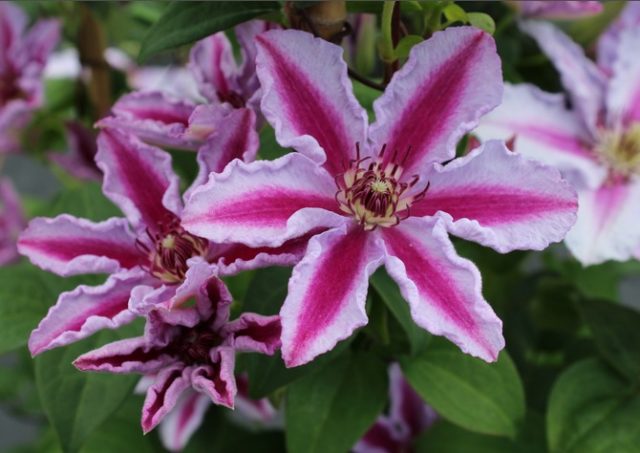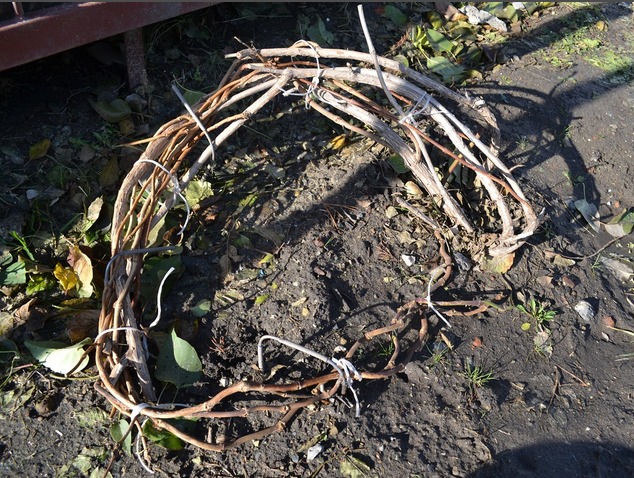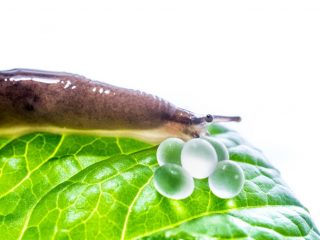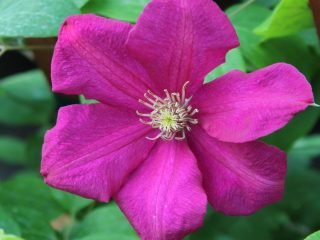Content
Clematis Tudor is a variety of German selection. It was bred in 2009, the originator of the variety is Willen Straver. Clematis large-flowered, early, is characterized by long, abundant flowering, ease of care and frost resistance.
Description of clematis Tudor
Large-flowered clematis Tudor, named after the English royal dynasty, looks majestic. Pale purple flowers with longitudinal, purple stripes in the middle of the petals are reminiscent of the Tudor family coat of arms. The diameter of the corollas is from 8 to 12 cm. The flowers have 6 petals, in the center there are purple anthers on snow-white stalks.
The bush is compact, low, the maximum height of shoots is 1.5-2 m. It blooms twice, the first time - from May to June, and the second time - from July to August. The leaves are pale green, trifoliate. The plant tolerates frosts well down to -35 °C.
Clematis Tudor pruning group
According to the description, clematis Tudor belongs to the 2nd pruning group. The first abundant flowering occurs in the spring on last year's shoots. The plant blooms for the second time at the end of summer after pruning, on the branches of the current year. In autumn, clematis requires light pruning at a height of 1 m from the ground.
Planting and caring for clematis Tudor
To plant clematis Tudor, choose a place protected from the winds and well lit most of the day. The roots of the plant do not like overheating, so the tree trunk circle should be in the shade. It is covered with mulch and shade is created thanks to ornamental crops planted nearby. The plant does not like acidic soil and stagnant water.
Planting order for clematis Tudor:
- A large hole is dug for clematis, about 60 cm in diameter and depth.
- If the soil is heavy, make a 15 cm drainage layer at the bottom and add peat to loosen it.
- Gravel and expanded clay are used as drainage.
- A deoxidizer and nutrients are added to the soil - rotted compost, bone meal, manure, complex mineral fertilizers.
- A piece of non-woven material that allows water to pass through, or coconut fiber, is placed on top of the drainage layer.
- Then the prepared nutrient soil is poured, leveled and compacted.
- Dig a small hole in the center according to the size of the root system of the container seedling.
- If the plant has an open root system, make a small tubercle at the bottom of the hole, along which the roots are spread.
- When planting, the root collar is deepened to 8-10 cm; if all the shoots are lignified, the green branches cannot be buried.
- Cover with soil and compact, make a small groove within a radius of 10 cm from the plant.
- Place a strong support nearby that will not shake from the wind; clematis shoots have very fragile wood.
- Water the tree trunk circle of the seedling from a watering can.
- Mulch the soil with sawdust or coconut fiber.
- On the sunny side, cover the seedling with a screen made of white non-woven covering material for 1.5 months.
Further care consists of regular watering as the soil dries out; the roots should not suffer from lack of moisture.
Photos of Tudor clematis flowers, according to reviews, leave no one indifferent. It blooms at the age of 3 years, after which it requires special pruning. The lashes of flowering specimens are shortened slightly in the fall, at a height of about 1 m from the ground, covered with spruce branches, spunbond or lutrasil on a frame. In the second year of cultivation, fertilizing with complex fertilizers is carried out from April to August.
Preparing for winter
In autumn, the tree trunk of Tudor clematis is covered with mulch. To do this, use peat, humus, and leaf litter. After pruning in October, the lashes are removed from the support and an air-dry shelter is built for them, as for roses. Cover with covering material when the air temperature drops to -4... -5 °C. The lashes can be rolled into a ring, but then cracks will appear on the bark; it is more convenient to lay them directly on a layer of mulch, pine litter or spruce branches.
The mulch layer is made higher than in spring and summer - about 15 cm. Before covering the bush with spunbond, preventive spraying is carried out with Fundazol.
Reproduction
Clematis Tudor is propagated by dividing the bush, layering and cuttings. When growing seedlings from seeds, varietal characteristics are not transmitted.
Reproduction by dividing the bush:
- Divide adult clematis Tudor in September during autumn transplantation.
- To do this, dig around the bush around the perimeter. It is important that the shovel is sharp and does not injure the roots.
- The soil is carefully shaken off the root system and the bush is divided into several large seedlings with shoots and renewal buds.
- The cuttings are planted immediately in a new place, deepening the root collar.
- Water the tree trunk circle and cover it with mulch.
Cuttings for propagation are usually cut in the summer in the first half of June. Young woody shoots take root better. From one lash, cut near the ground above a strong bud, you can get several cuttings with 2-3 internodes. Rooting occurs in a greenhouse at high humidity and air temperature +22… +25 °C.
Having seen the photo and description of clematis Tudor, many will want to purchase its seedlings. It is very easy to propagate the plant by layering. To do this, in the spring, a ditch is dug next to the bush with a depth of up to 20 cm and a length of up to 1 m. It is filled with fertile, loose substrate with the addition of humus and vermicompost. One of the long shoots of clematis is bent and placed in a prepared ditch, sprinkled with soil, and secured with wooden or steel slingshots. Water it all summer and feed it with fertilizers along with the mother bush. Rooted seedlings are separated in the spring or autumn of next year and transplanted to a new location.
Diseases and pests
It is a shame to lose this beautiful Tudor clematis variety due to an oversight. Even a healthy plant with a strong immune system is sometimes attacked by pests or suffers from fungal diseases.
Among the pests on clematis Tudor, aphids, slugs, and spider mites can settle; in winter, mice gnaw at the shoots under cover. Poisoned grain is used to control rodents, slugs are collected by hand, and Fitoverm or other insectoacaricides help in the fight against aphids and spider mites.
The most common fungal diseases on clematis are rust, powdery mildew, gray rot and wilt. Those gardeners who treat plants with fungicides in the fall and spring generally believe that they never get sick.
Conclusion
Clematis Tudor is a low vine with large bright flowers. It is highly decorative. Requires shelter and light pruning in the fall. The plant is easy to care for, tolerates frost well and rarely gets sick.










